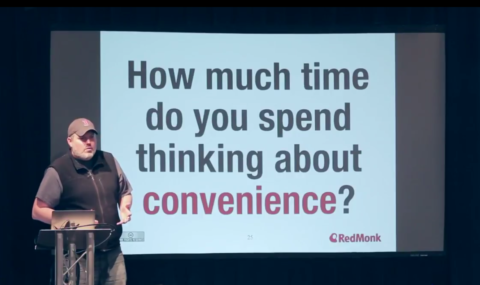RedMonk recently hosted the sixth annual Monki Gras conference. We had two excellent of days of talks focused on the themes of packaging and convenience. My colleague James framed the discussion as such:
Great packaging is the basis for all effective product and community management today. Whether in open source, cloud, consumer or business to business services, the companies that are really successful are masters at packaging.
Software Packaging
The concepts of quality packaging and convenience are innately tied. As Claire Giordano said in her talk, “the best packaging enables convenience.” Speakers presented a variety of ways to think about packaging software and creating convenience, including:
– how and where is a product available, and how it is accessed? We are in an era where discussion of Docker images and containers are unavoidable in discussions of packaging; while those are both interesting and important, there was also a broader discussion around principles of distribution. Spend time thinking about a product’s delivery and distribution compared to your competitors, and particularly think about how your product competes with the service delivery of cloud platforms.
– how easily does a product integrate with other products/platforms/tools? Products that easily fit into existing workflows and toolchains are more likely to be adopted. Consider how you can build or partner to create simple, out-of-the-box integrations.
– how is the product documented? Documentation was a indirect theme of the conference, with several speakers touching on how imperative good docs are to user adoption. As David Pollack stated, “don’t allow Google and Stack Overflow to be your core knowledge base.” Invest energy in good documentation that is targeted for your users. Focus on your end users’ needs, because, as Kiyoto Tamura said, “documentation is your opportunity to package your software around jobs to be done.”
– how has a product been marketed and “packaged” with storytelling? As Austen Collins pointed out in his talk, story is not often mentioned in engineering culture. However, it can be a deeply powerful way to build context around a product. A well-crafted marketing message helps people cognitively package your product.
A trend that repeatedly emerged was the concept that the best technology isn’t always the triumphant technology. While the assertion that a product doesn’t compete solely on its specs certainly isn’t novel, the conference provided an enlightening and extended discussion around packaging as an area of differentiation. If better packaging can increase convenience and improving convenience increases adoption, then it makes sense to focus on packaging and convenience as competitive assets.
Potential Pitfalls
When you use convenience as a frame of reference, the scope and source of competition broadens. For example, Kafka’s threat isn’t simply from Amazon’s Kinesis; Kafka is actually competing against the convenience of all of AWS’ products as a bundle.
However, bundling alone is not enough. Convenience is more than a proliferation of options; it is helping users understand their options in context. The plethora of information can make it overwhelming to understand options and place solutions in context. This is where documentation and storytelling come into play; helping consumers navigate complexity is a key component of packaging.
While we commonly hear about the difficulty companies face in regards to market fragmentation and the overwhelming choice it creates, it important to remember that consumers can also struggle to find the optimal path forward within a single vendor.
An example of this struggle came from the recent CoreOS’ Tectonic Summit in December. The Ticketmaster keynote presentation included an interesting customer perspective; in their discussion about their Kubernetes strategy, they included a comparison to running services on AWS. Their conclusion was that if you assume a workload has one optimal price-performance-value ratio and there were 65,000 permutations to combine all of AWS’ service offerings, then there were 64,999 ways to use AWS “wrong.” While this view is hyperbolic, it is indicative of the cognitive overload many people face when trying to decipher the complexities of the technological landscape. In a world of ever expansive choices, a focus on good packaging can help consumers see increased optionality as a benefit rather than a burden; simply put, packaging can give customers more opportunities to feel like they’re doing it “right.”
Companies that are focused on convenience therefore strive not only to create an easy-to-use technology with a wide distribution and simple integrations, but also to help consumers contextually understand their product. It’s not enough to make your product easily available; you also have to make it easy to understand and easy to contextualize.
Additional Details
If you want to dive into any of these topics in more detail, the conference talks are an excellent resource. Videos are currently being released daily and there is lots of great content still to come. Many thanks to all the speakers for their fantastic talks!
We also extend our gratitude to our friends at Pivotal, HPE, Red Hat, The Eclipse Foundation, Funcatron, Weaveworks, AWS, Varnish Software, Treasure Data, NVIDIA, Bitnami, and Snyk for making the conference possible through their generous sponsorship.
Disclosure: Pivotal, HPE, Red Hat, AWS, Varnish Software, Treasure Data, and Bitnami are RedMonk clients.


No Comments